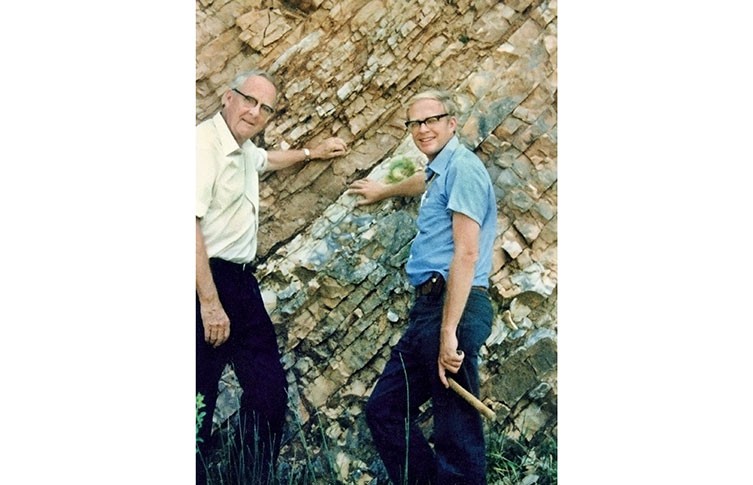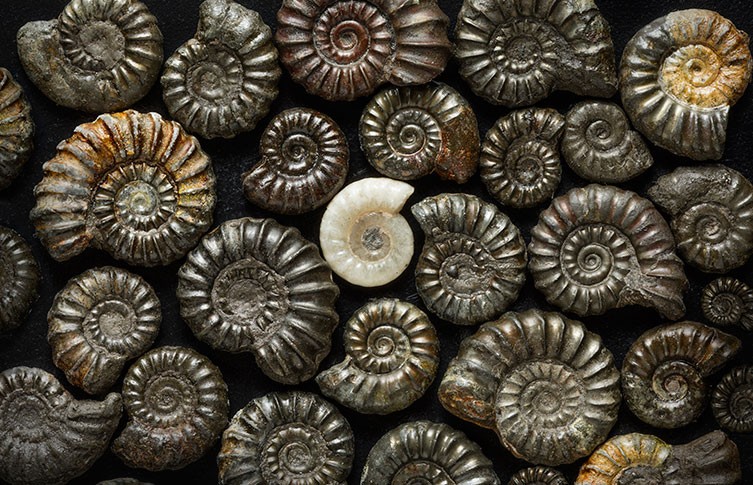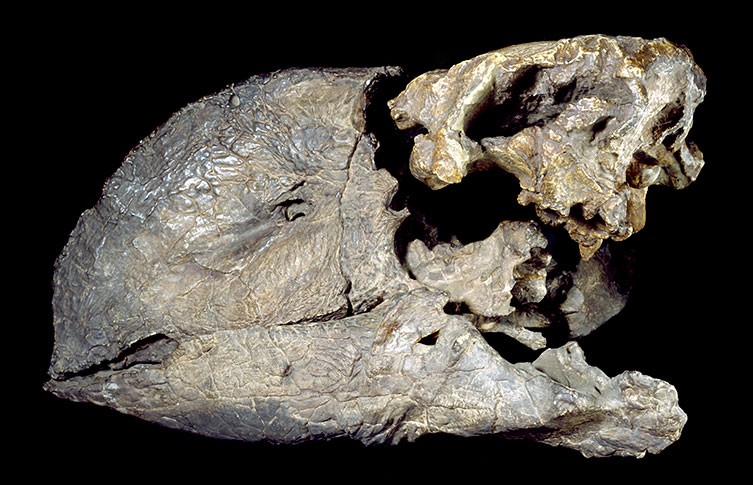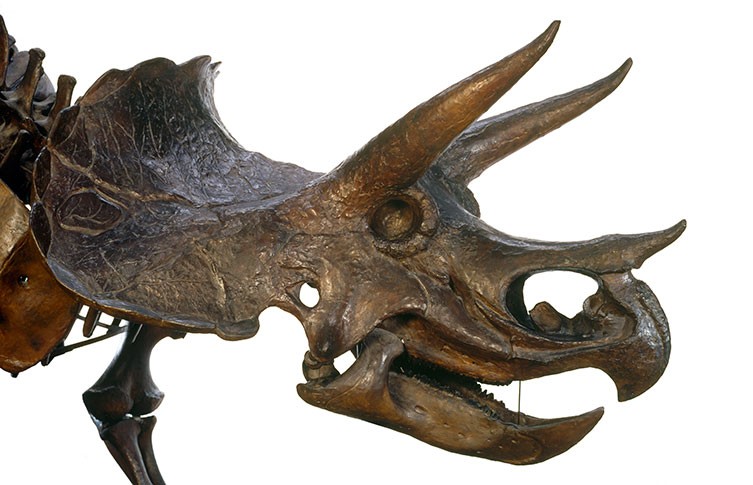Did you know that the reign of the dinosaurs, lasting an incredible 180 million years, ended abruptly due to a catastrophic event? At WHY.EDU.VN, we delve into the fascinating story of dinosaur extinction, exploring the leading theories and evidence that explain this pivotal moment in Earth’s history. Join us as we explore the geological impact of this moment in time and reveal the reasons behind this extinction event. Discover insights into the Cretaceous-Paleogene extinction and the theories behind the demise of these giants.
1. The Asteroid Impact Theory: A Cataclysmic Collision
The asteroid impact theory, popularized by physicist Luis Walter Alvarez and his geologist son Walter in 1980, is the most widely accepted explanation for the extinction of the dinosaurs. This theory suggests that a large asteroid collided with Earth approximately 66 million years ago, triggering a series of catastrophic events that led to the demise of the non-avian dinosaurs and many other species. This hypothesis is also known as the Alvarez hypothesis.
1.1. Evidence Supporting the Asteroid Impact
- Iridium Anomaly: A layer of clay rich in iridium, a rare element on Earth but abundant in meteorites, has been found worldwide at the Cretaceous-Paleogene (K-Pg) boundary, marking the time of the dinosaur extinction.
- Chicxulub Crater: The Chicxulub crater, a massive impact crater located on the Yucatán Peninsula in Mexico, is believed to be the site of the asteroid impact. The crater is approximately 150 kilometers (93 miles) in diameter and dates back to the same time as the K-Pg boundary.
- Shocked Quartz: Shocked quartz, a type of quartz crystal that has been structurally deformed by intense pressure, has been found at the K-Pg boundary. This type of quartz is typically formed during asteroid impacts or nuclear explosions.
- Tektites: Tektites, small glassy objects formed from molten rock ejected during an impact event, have also been found at the K-Pg boundary.
- Widespread Wildfires: Evidence of widespread wildfires, possibly triggered by the heat and debris from the impact, has been found in the fossil record.
1.2. The Immediate Effects of the Impact
The impact of a massive asteroid would have had devastating immediate effects on the surrounding area. The impact would have generated:
- A Massive Shockwave: The impact would have created a powerful shockwave that radiated outward from the impact site, flattening everything in its path.
- Intense Heat: The impact would have generated intense heat, igniting wildfires and causing widespread devastation.
- Tsunamis: The impact would have triggered massive tsunamis that inundated coastal areas.
- Ejecta: The impact would have ejected vast amounts of rock and debris into the atmosphere, some of which would have rained back down on Earth, causing further destruction.
1.3. The Long-Term Effects of the Impact
The long-term effects of the asteroid impact would have been equally devastating. The ejecta thrown into the atmosphere would have:
- Blocked Sunlight: The dust and debris would have blocked sunlight, leading to a period of darkness and cooling known as an “impact winter.”
- Disrupted Photosynthesis: The reduced sunlight would have disrupted photosynthesis, causing plant life to die off and leading to a collapse of the food chain.
- Acid Rain: The impact would have released large amounts of sulfur dioxide into the atmosphere, which would have combined with water vapor to form acid rain, further damaging plant life and ecosystems.
- Global Cooling: While the initial impact may have caused a brief period of intense heat, the long-term effect would have been global cooling due to the reduced sunlight.
2. Volcanic Activity: The Deccan Traps Eruption
While the asteroid impact is the most widely accepted cause of the dinosaur extinction, some scientists believe that volcanic activity may have also played a significant role. The Deccan Traps, a large igneous province in India, experienced massive volcanic eruptions around the time of the K-Pg extinction event.
2.1. The Deccan Traps and Climate Change
The Deccan Traps eruptions released massive amounts of gases, including carbon dioxide and sulfur dioxide, into the atmosphere.
- Carbon Dioxide: Carbon dioxide is a greenhouse gas that traps heat in the atmosphere. The release of large amounts of carbon dioxide from the Deccan Traps eruptions may have led to a period of global warming.
- Sulfur Dioxide: Sulfur dioxide can react with water vapor in the atmosphere to form sulfate aerosols, which reflect sunlight and can lead to global cooling. The release of large amounts of sulfur dioxide from the Deccan Traps eruptions may have led to a period of global cooling.
2.2. A One-Two Punch
The combined effects of the asteroid impact and the Deccan Traps eruptions may have created a “one-two punch” that led to the extinction of the dinosaurs. The asteroid impact would have caused immediate devastation, while the Deccan Traps eruptions would have caused long-term climate change, making it difficult for the dinosaurs to survive.
3. Sea Level Changes: Marine Regression
Changes in sea level may have also contributed to the dinosaur extinction. During the late Cretaceous period, sea levels were relatively high, creating large shallow seas that covered much of the continents. However, towards the end of the Cretaceous, sea levels began to decline, leading to a marine regression.
3.1. Habitat Loss and Competition
The marine regression would have led to a loss of habitat for many marine organisms, including marine reptiles and plankton. This loss of habitat may have led to increased competition for resources and contributed to the extinction of some species.
3.2. Changes in Climate and Ocean Currents
The marine regression may have also led to changes in climate and ocean currents. The loss of shallow seas may have reduced the amount of moisture in the atmosphere, leading to drier conditions on land. Changes in ocean currents may have also disrupted marine ecosystems.
4. Other Factors: A Complex Web of Interactions
In addition to the asteroid impact, volcanic activity, and sea level changes, other factors may have also contributed to the dinosaur extinction. These factors include:
- Disease: The spread of disease may have weakened dinosaur populations, making them more vulnerable to extinction.
- Competition with Mammals: Mammals were becoming more diverse and abundant during the late Cretaceous period. Competition with mammals for resources may have put pressure on dinosaur populations.
- Changes in Plant Life: The composition of plant life was changing during the late Cretaceous period. The decline of ferns and the rise of flowering plants may have altered dinosaur diets and ecosystems.
5. Survival and Evolution: The Dawn of a New Era
While the dinosaur extinction was a catastrophic event, it also created opportunities for other species to thrive. Mammals, birds, and other groups of animals that had been relatively small and inconspicuous during the age of the dinosaurs were able to diversify and evolve into new forms.
5.1. Birds: The Surviving Dinosaurs
Birds are the direct descendants of theropod dinosaurs, a group of carnivorous dinosaurs that includes Tyrannosaurus rex. Birds survived the K-Pg extinction event, and today they are one of the most diverse groups of vertebrates on Earth.
5.2. Mammals: The Rise of a New Dominant Group
Mammals were relatively small and uncommon during the age of the dinosaurs, but they diversified rapidly after the K-Pg extinction event. Mammals evolved into a wide range of forms, including primates, rodents, whales, and bats.
5.3. A New World
The extinction of the dinosaurs marked the end of the Mesozoic Era and the beginning of the Cenozoic Era, also known as the “Age of Mammals.” The Cenozoic Era has been characterized by the diversification and evolution of mammals, birds, and other groups of animals, leading to the world we know today.
6. Could the Dinosaurs Have Survived? A Hypothetical Scenario
It is fascinating to consider whether the dinosaurs could have survived the K-Pg extinction event under different circumstances. Some scientists believe that if the asteroid impact had occurred in a different location, the effects may have been less severe.
6.1. A Different Impact Site
If the asteroid had landed in a deep ocean basin, the amount of dust and debris ejected into the atmosphere may have been less, reducing the severity of the impact winter.
6.2. A Less Severe Impact
If the asteroid had been smaller or had hit at a shallower angle, the amount of energy released during the impact may have been less, reducing the overall devastation.
6.3. A World Without Mammals
If mammals had not been present during the late Cretaceous period, the dinosaurs may have been able to adapt to the changing environmental conditions and survive the K-Pg extinction event.
6.4. A Different Outcome?
It is impossible to know for sure whether the dinosaurs could have survived under different circumstances. However, it is clear that the K-Pg extinction event was a pivotal moment in Earth’s history, and that it had a profound impact on the evolution of life on our planet.
7. The Last Dinosaurs: A Glimpse into the End of an Era
The fossil record provides a glimpse into the last days of the dinosaurs. The last known non-avian dinosaurs lived in western North America, in what is now Montana and the Dakotas.
7.1. Tyrannosaurus rex and Triceratops
The last dinosaurs included iconic species such as Tyrannosaurus rex and Triceratops. These dinosaurs were thriving in terms of numbers, but the number of different types of dinosaurs was reduced.
7.2. A World on the Brink
The world of the last dinosaurs was a world on the brink of disaster. The asteroid impact was imminent, and the dinosaurs were living on borrowed time.
7.3. The End of an Era
The K-Pg extinction event marked the end of an era for the dinosaurs. After 180 million years of dominance, the dinosaurs were gone, leaving behind a world ripe for new forms of life to evolve and flourish.
8. Unearthing the Past: Continued Research and Discoveries
Scientists continue to study the dinosaur extinction, making new discoveries and refining our understanding of this pivotal event in Earth’s history.
8.1. New Fossil Discoveries
New fossil discoveries are constantly shedding light on the lives of the dinosaurs and the circumstances surrounding their extinction.
8.2. Advanced Technologies
Advanced technologies, such as CT scanning and geochemical analysis, are providing new insights into the fossil record and the events surrounding the K-Pg extinction event.
8.3. A Deeper Understanding
Continued research and discoveries are helping us to develop a deeper understanding of the dinosaur extinction and its impact on the evolution of life on Earth.
9. Why Study the Dinosaur Extinction? Lessons for the Future
The dinosaur extinction is not just a story about the past; it also provides valuable lessons for the future.
9.1. Understanding Mass Extinctions
Studying the dinosaur extinction can help us to understand the causes and consequences of mass extinctions, events in which a large percentage of Earth’s species die out in a relatively short period of time.
9.2. Climate Change and Biodiversity Loss
The dinosaur extinction provides a stark reminder of the potential impacts of climate change and biodiversity loss.
9.3. Protecting Our Planet
By learning from the past, we can take steps to protect our planet and prevent future mass extinctions.
10. Exploring Dinosaur Extinction Theories Further at WHY.EDU.VN
Interested in learning more about the fascinating story of dinosaur extinction? Visit WHY.EDU.VN to explore a wealth of information on this topic, including:
- In-depth articles: Delve into detailed discussions of the asteroid impact theory, volcanic activity, sea level changes, and other factors that may have contributed to the dinosaur extinction.
- Expert insights: Read articles written by leading paleontologists and scientists who are actively researching the dinosaur extinction.
- Interactive resources: Explore interactive maps, timelines, and simulations that bring the story of the dinosaur extinction to life.
- Q&A with experts: Submit your questions about the dinosaur extinction and receive answers from our team of experts.
At WHY.EDU.VN, we are committed to providing accurate, reliable, and engaging information about the world around us. Join us as we explore the mysteries of the dinosaur extinction and learn valuable lessons for the future.
For any questions or further information, please contact us at 101 Curiosity Lane, Answer Town, CA 90210, United States, Whatsapp: +1 (213) 555-0101 or visit our website at WHY.EDU.VN.
Five search intentions related to the primary keyword:
- Seeking a detailed explanation of the asteroid impact theory: Users want to understand the evidence supporting the theory that an asteroid impact caused the extinction of the dinosaurs.
- Understanding the role of volcanic activity in the extinction: Users are interested in learning about the Deccan Traps eruptions and their potential impact on the climate and the extinction event.
- Learning about the factors that contributed to dinosaur extinction: Users want to explore other factors, such as sea-level changes and diseases, that may have played a role in the extinction.
- Discovering which animals survived the K-Pg extinction event: Users are curious about which animals survived the event and how they evolved into new forms.
- Exploring the lessons that the dinosaur extinction can teach us: Users want to understand the relevance of the dinosaur extinction to contemporary issues, such as climate change and biodiversity loss.
FAQ: Unraveling the Dinosaur Extinction Mystery
Here are some frequently asked questions (FAQ) regarding the extinction of dinosaurs.
| Question | Answer |
|---|---|
| What is the most widely accepted theory about dinosaur extinction? | The asteroid impact theory, which suggests a large asteroid collided with Earth, causing catastrophic events that led to their demise. |
| What evidence supports the asteroid impact theory? | The iridium anomaly, the Chicxulub crater, shocked quartz, tektites, and evidence of widespread wildfires support this theory. |
| How big was the asteroid that impacted Earth? | It’s estimated to have been between 10 and 15 kilometers in diameter. |
| What were the immediate effects of the asteroid impact? | A massive shockwave, intense heat, tsunamis, and the ejection of vast amounts of debris into the atmosphere. |
| How did volcanic activity contribute to the extinction? | The Deccan Traps eruptions released massive amounts of gases, including carbon dioxide and sulfur dioxide, leading to climate change. |
| What other factors contributed to the extinction? | Sea level changes, diseases, competition with mammals, and changes in plant life may have also played a role. |
| Which animals survived the K-Pg extinction event? | Birds, mammals, and other groups of animals that were relatively small and inconspicuous during the age of the dinosaurs survived and evolved into new forms. |
| Are birds the descendants of dinosaurs? | Yes, birds are the direct descendants of theropod dinosaurs. |
| Could the dinosaurs have survived under different circumstances? | It is possible that if the asteroid impact had occurred in a different location or if the impact had been less severe, the dinosaurs may have been able to survive. |
| What lessons can we learn from the dinosaur extinction? | We can learn about the causes and consequences of mass extinctions and the potential impacts of climate change and biodiversity loss. This knowledge can help us take steps to protect our planet and prevent future mass extinctions. |




Are you still curious about the how and why behind the dinosaur extinction? At WHY.EDU.VN, we understand your thirst for knowledge. That’s why we’ve created a platform where you can delve deeper into this topic and countless others. Don’t let your questions linger – visit WHY.EDU.VN today and connect with experts who can provide the answers you seek. Let curiosity lead you to discovery with why.edu.vn.